What is rutabaga, how does it grow, what is it useful for and where is it used?
Rutabaga is a biennial plant from the cabbage family that has forage and nutritional value. Rutabaga is often called fodder beet, which is fundamentally wrong, since these are completely different plants and belong to different families.
Rutabaga - what it is, what it looks like and where it is used, photo of the plant - read about everything in our material.
What kind of vegetable is this
Rutabaga is a plant with a spherical root crop that produces high yields on sandy and loamy soils. It is one of the main table root vegetables in Sweden, Germany, and Finland.
What does the plant and fruits look like?
In the first year of cultivation, rutabaga is a root crop with a rosette of leaves. In the second year, flowering shoots and seeds develop.
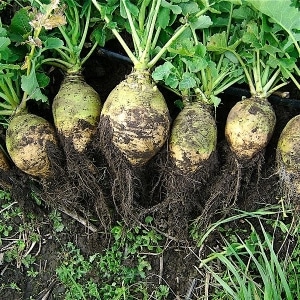 Root vegetables have a round, cylindrical or oval shape, depending on the variety. The pulp is yellow with various shades or white. The color of the peel protruding above the surface of the soil is gray-green or purple. The underground part is painted yellow.
Root vegetables have a round, cylindrical or oval shape, depending on the variety. The pulp is yellow with various shades or white. The color of the peel protruding above the surface of the soil is gray-green or purple. The underground part is painted yellow.
The stem is tall and straight. The lower leaves are lyre-shaped, incised. The leaves on the stem are entire, sessile.
The structure of the inflorescence has the shape of a brush with small golden-yellow flowers, characteristic of cruciferous plants.
In the second year of growth, rutabaga ripens dark brown spherical seeds with a diameter of about 1.8 mm, enclosed in a multi-seeded pod 5-10 cm long.
Characteristics
Biological characteristics are given in the table.
| Parameter | Description |
| Family | Brassicas |
| Genus | Cabbage |
| View | Rape |
| Plant type | Two-year |
| Relation to air temperature | The plant is cold-resistant, seeds germinate at +1... +3ºС, sprouts can withstand short-term temperature drops to -4ºС. The best quality root vegetables grow at + 15… + 18ºС. It is resistant to prolonged heat, but the roots become tough. |
| Relation to moisture | Moisture-loving plant. With a lack of water, root crops become bitter and premature flowering begins. |
| Attitude to light | When planting in the ground, shaded areas should be avoided. |
Homeland and history of vegetable culture
According to some scientists, rutabaga comes from the Mediterranean, where it was obtained through natural or deliberate crossing of cabbage and turnips.
However, any facts in written sources before the start XVII no century. It was not until 1620 that the Swiss botanist Caspar Baugin described a rutabaga-like plant found in the wild flora of Sweden.
According to another theory, rutabaga was first cultivated in Siberia, from where it came to the countries of Northern Europe. This opinion is supported by the various names of rutabaga in the regions of Russia: brucla, bruchka, gruhva, zemlyanukha and others.
This is interesting:
What vitamins are in radishes and how are they good for health?
How and where it grows
The culture is popular in the Scandinavian countries, Germany, and Sweden. In our country, rutabaga was replaced by potatoes, although in Tsarist Russia the production of the root crop was up to 300 thousand tons per year.
Regions with cool summers are most favorable for growing rutabaga.
Agricultural technology
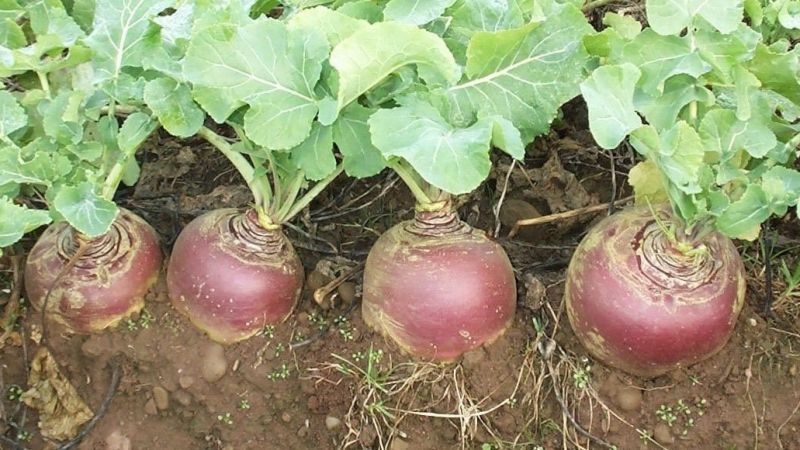
It is not difficult to grow a vegetable on your own plot, knowing the nuances of root crop agricultural technology.
Soil preparation
Acidic and neutral soils with a pH of 5.5-7.0 are suitable for rutabaga.The soil should be loose and nutritious.
Reference. Loam, sandy loam, and cultivated peat are suitable for growing rutabaga.
Good drainage is important: it is not recommended to plant vegetables in areas with high groundwater.
Beginning in the fall, the beds should be carefully dug up and phosphorus-potassium fertilizers and organic matter applied.
Predecessors
The vegetable feels good in beds where cucumbers, legumes, zucchini, tomatoes, peppers, and potatoes previously grew.
You should not plant rutabaga after cabbage, radishes, radishes, horseradish, and turnips.
Sowing seeds
Seeds are sown in open ground in early May to a depth of about 2.5 cm. 45-50 cm are left between rows.
Thinning of the sprouts is carried out at the stage of two true leaves, leaving a distance between the bushes of 4-5 cm. After the appearance of four leaves, the plantings are re-drilled so that about 15 cm remains between the plants.
The seedling method of growing rutabaga is also practiced. Seeds are sown to a depth of 1.5 cm in previously prepared containers with soil. The seedlings are ready to be transplanted to a permanent location when the third true leaf appears.
Weeding and loosening
During the season you will need to loosen the soil only 4-5 times. This procedure is combined with weed removal. Soil cultivation is carried out to a depth of 4-8 cm.
Watering
Rutabaga needs abundant watering: approximately 10 liters per 1 sq. m. Such powerful waterings need no more than 3-5 during the summer; the rest of the time they water based on the condition of the plants.
Feeding
The first fertilizing is carried out two weeks after emergence or planting of seedlings. Fertilizers are applied a second time at the beginning of the formation of root crops.
Complex mineral fertilizers are used for processing. Rutabaga needs potassium, phosphorus, boron.
Pests and diseases
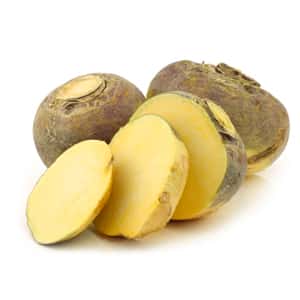 Rutabaga is characterized by the same diseases and pests as cabbage, radish, and turnips.
Rutabaga is characterized by the same diseases and pests as cabbage, radish, and turnips.
The vegetable is susceptible to felt disease, mosaic, vascular bacteriosis, and blackleg.
Dangerous pests include slugs, bedbugs, aphids, flea beetles, and cabbage flies.
If necessary, chemicals are used to treat pests, depending on the type of parasite or disease.
For prevention, it is necessary to observe crop rotation, treat seeds before planting, carry out timely weeding, and remove all plant debris from the beds.
Harvesting and storage
Root crops are harvested 3-4 months after planting the seedlings. For long-term storage, rutabaga is harvested shortly before the first frost.
On a note. Root vegetables with thick lateral shoots are discarded; they have coarse, tasteless pulp.
Leaves are cut off from vegetables taken from the ground at the very base and laid out to dry in a dark place. The harvest is stored in unheated rooms or cellars.
Rutabaga varieties
There are two varieties of rutabaga:
- table - with yellow tender, juicy pulp and a pleasant aftertaste;
- aft - has a more rigid and coarse structure.
The following table varieties are most in demand among vegetable growers:
- Krasnoselskaya. The formation of root crops occurs 90-120 days after the appearance of sprouts. The fruits are flat-round in shape with delicate sugary pulp. Weight from 300 to 600 g.
- Novgorodskaya. The harvest is harvested 120 days after germination. The pulp is yellow, dense and juicy. The weight of the root crop is about 400 g.
- Child love. Reaches technical ripeness 90-120 days after planting in the ground. The root vegetable is round in shape, weighing 350-400 g. The taste is excellent, the vegetable is juicy and sweet.Productivity from 6 to 6.5 kg per 1 sq. m.
- Vereiskaya. It takes 85-90 days from sowing to harvesting. The fruit is flat-rounded, with a delicate and juicy structure. Productivity is low: up to 4 kg per 1 sq. m.
Beneficial features
Rutabaga has long been considered a product that strengthens the immune system and restores vitality.
Eating vegetables has a positive effect on the body:
- toxins are eliminated;
- metabolic processes are accelerated;
- blood vessels are strengthened;
- blood pressure is normalized;
- cholesterol levels decrease;
- strengthens bone and dental tissue;
- tissue regeneration processes are accelerated.
Rutabaga has a mild diuretic and laxative effect.
Composition and nutritional value
Rutabaga is rich in B vitamins, contains vitamins E, K, PP, lycopene, beta-carotene, and unsaturated fatty acids.
100 g of vegetable contains 30 mg of vitamin C, which is one third of a person’s daily requirement.
The product contains minerals: potassium, calcium, magnesium, phosphorus, iron.
Nutrient content per 100 g of edible part:
- proteins - 1.2 g;
- fats - 0.1 g;
- carbohydrates - 7.7 g.
Eating 300 g of vegetables covers 30% of the body's daily need for dietary fiber.
Application
Thanks to its rich vitamin and mineral composition and unusual taste, rutabaga is used both in cooking and in folk medicine.
In cooking
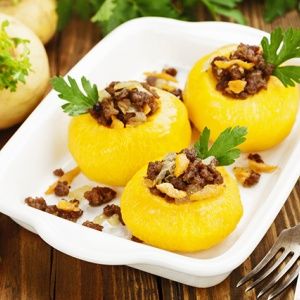
The raw root vegetable is sweet, juicy and aromatic.
When boiled, it resembles potatoes, so it can replace it in salads and side dishes. Baked rutabaga is a healthy and tasty delicacy.
Rutabaga is eaten fresh, boiled, stewed, and used to make juice. With the addition of vegetables, pancakes and cutlets are fried, porridges, soups, and pie fillings are prepared.
Rutabaga goes well with other vegetables, especially potatoes and cabbage. Regardless of the cooking method, it serves as an excellent low-calorie side dish for meat and fish dishes.
In folk medicine and cosmetology
Rutabaga juice and crushed pulp are used in folk medicinal and cosmetic products.
Porridge mixed with honey in a 2:1 ratio alleviates colds and acute respiratory viral infections. You need to take one teaspoon of the product before meals with plenty of water.
Gently solves the problem of constipation by eating 100-150 g of baked rutabaga every other day.
Compresses made from grated root pulp will help cope with minor burns, purulent rashes and skin damage.
For acne, it is recommended to wipe your face with rutabaga juice at night.
To moisturize dry skin, apply a mask of pureed vegetable pulp and an equal amount of sour cream for 15 minutes 2-3 times a week.
Read also:
Unusual and very tasty rutabaga recipes from experienced housewives.
Review of the best radish varieties for open ground and greenhouses.
What vitamins are in radishes and how are they good for health?
Rutabaga recipes
Rutabaga dishes are simple; even a novice housewife can prepare them. Appetizers, salads, first and second courses, and desserts are prepared with vegetables.
Rutabaga salad with carrots
Grate medium-sized rutabaga, scald with boiling water, then immediately rinse with cold water. Squeeze out the moisture and mix with one grated large carrot. Add a handful of raisins and crushed walnuts. Season with sour cream and herbs.
Vegetable puree soup
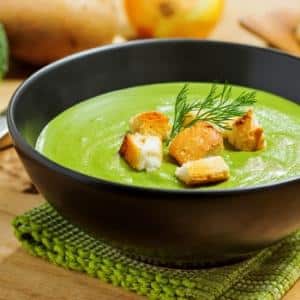
To prepare the soup, in addition to rutabaga, you will need cabbage, carrots, zucchini, potatoes, and onions. Vegetables are washed, peeled, cut into pieces, and cooked until tender.
Then, together with the broth, they are crushed in a blender. Serve seasoned with salt, pepper and chopped herbs.
Rutabaga stuffed with mushrooms
Small root vegetables are boiled for 1.5-2 hours. Carefully remove the pulp, leaving walls 8-10 mm thick. The preparations are filled with mushrooms fried with onions and rutabaga pulp, and grated carrots are added if desired.
Place the portions in a thick-walled saucepan, add water and simmer for about 15 minutes, tightly closing the lid.
Rutabaga pudding
Ingredients for two servings: rutabaga - 75 g, apricots - 50 g, cottage cheese - 50 g, one egg white, milk - 30 g, butter - 10 g, sugar - 10 g, semolina - 10 g, sour cream - 30 g .
The rutabaga is cut into strips and stewed with butter and milk until tender. Add cereal, sugar and soaked chopped apricots to the resulting mass. The mass is thoroughly mixed and cooled. Add mashed cottage cheese and whipped egg whites and stir. Place in a greased mold and bake until golden brown. Served with sour cream.
Contraindications
Despite the enormous benefits, there are a number of contraindications to consuming vegetables:
- exacerbation of gastrointestinal diseases (gastritis, colitis, peptic ulcer);
- diabetes;
- flatulence;
- pregnancy and breastfeeding.
It is not recommended to consume rutabaga for children under 3 years of age.
Conclusion
Rutabaga is an undeservedly forgotten root vegetable that is easy to grow in your garden. Side dishes and soups are prepared from the vegetable. With the addition of rutabaga, cutlets are fried and filling for pies is made. The product can be a healthy and low-calorie replacement for potatoes.
In traditional medicine recipes, the pulp is used to relieve colds and constipation. The juice is an excellent natural remedy for acne.It’s worth trying to grow this wonderful root vegetable and experience all its beneficial properties.